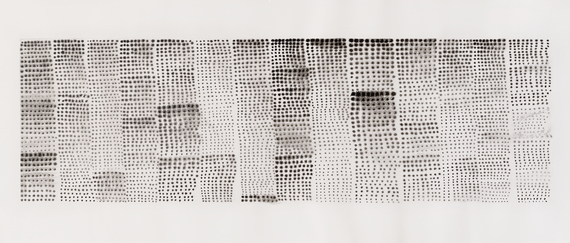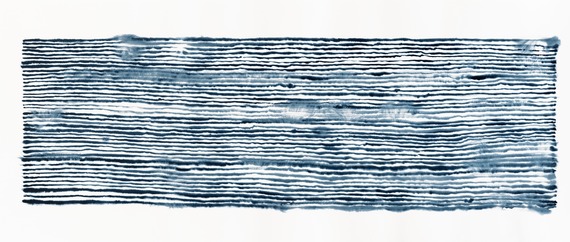Born into a family of artists whose work exploded with color, Susan Michie found her own path into artistic expression by eschewing bold tones and rich hues in favor of monochromatic blacks, whites and browns. Her delicate paintings and sketches focus more on the essence of the mark, which has allowed her to form her own pictorial language in order in search for her own artistic identity.
Her upcoming exhibition "The Drift of Hours," named for Michie's two most recent works, showcases both older and contemporary drawings and photographs at London's Hospital Club 22-25 January 2015.
Susan's work demonstrates an affinity with textiles and cuneiform lettering, combining texturised strokes with visual language on canvas. Her work carries an archaic quality, even though she has no academic background of the ancient cultures whose influence is apparent.
"Cuneiform has been an of interest of mine since childhood," she says, "Only a few people know what they mean, and while they appear abstract they are not random, they serve a purpose. I chose to deconstruct them into my own language. I've always liked to create scripts and use symbolic writing."
"Textile is another influence," she continues, "I love textiles as a source of ideas, along with the shapes that come from fabric. I've often used the Bayeaux Tapestry as a base to create the sense measurement that's important in my drawing."
There is an organic quality to Susan Michie's art, arising from using her own body to determine qualities of the painting. She'll use her body weight or height, cultivating rectangles and lines from the length of her arm to her full body frame.
"While I like to start off with script and textiles, natural forms are evident in my work."
The importance of scale and measurement shows in Susan's work, since the composition represents a fragile geometry where there is nothing random in the structure, even if the body of work shows the frailty of human fallibility in the physical process, which is a core part of Susan's philosophy. In fact, the human quality of her paintings, its relatable imperfections, are why so many feel a connection with Susan's art.
To understand Susan as an artist, it's important to look into her background. Coming from a pedigree sporting Britain's top artists, like grandmother Anne Redpath and her father Alastair Michie, made life harder for Susan to find her own feet as an independent artist.
"I come from the third generation of artists, where bold color was a family tradition. I wanted to move away from that and find my own voice, and I think the fact my paintings are devoid of color was an unconscious effect to break away from my family artistically. I have always been interested in being an artist, but coming from my family, it was a hard environment to play around with, especially since my father had high standards of what it meant to be an artist," says Susan, "I went into the film industry instead for a while, until I decided later in life to go back to art school and get my own studio. I started to play around and paint shapes, where I worked in black and white. Color handicapped my art before, because it wasn't my own style, it was my family's, but once I switched to approaching drawing as the essence of the mark, I knew it was the right way to work."
Susan's work not only carries a message of beauty and simplicity in form, but there is an underlying concept of femininity which is strong in her work. The delicate nature of her paintings, their attention to fine detail rather than bold forms carry a feminine quality.
"Femininity plays a big part in my work. My work is feminine, and I do not believe a man would paint or work the way I do, but in my opinion that is a strength. The art world is already dominated by male art, but the answer for female artists is to find our own strength, and not necessarily emulate men," Susan continue, "I choose not to sign my work on purpose, since historically and intrinsically that is how women's work has always been shown. Perhaps that doesn't fall into the contemporary feminist ideals. But even though my work has a female quality to it, doesn't mean it doesn't appeal to men as well as women. I think art can cross the gender boundary, and I hold a strong position that women don't have to be men to make a name for themselves in their art."
Susan Michie - Continuing an Old Pattern
A quality of Susan's paintings, are their sequential nature, which Susan draws from her belief in the validity and vitality of repetition in everyday life, from our daily tasks that add up to paint the whole picture. Her work demonstrates a rhythmic pulse and great patience, as each painting becomes an organic form that comes to life naturally.
"The Drift of Hours" will be exhibited at The Hospital Club in London, January 23-25, 2015, 12 p.m. - 8 p.m. free entry.



